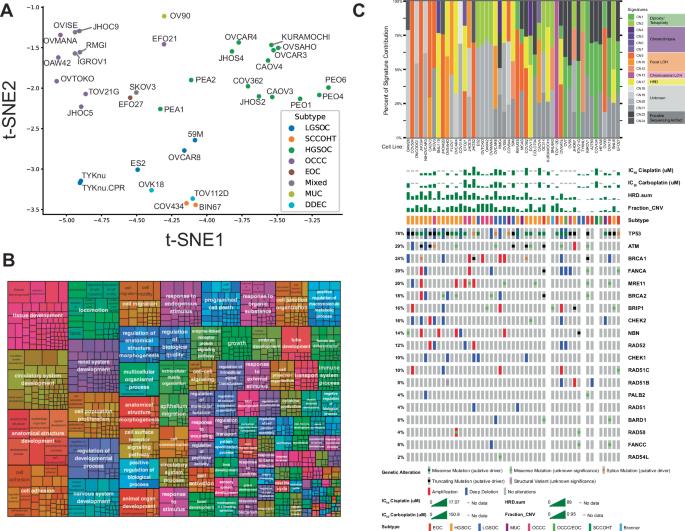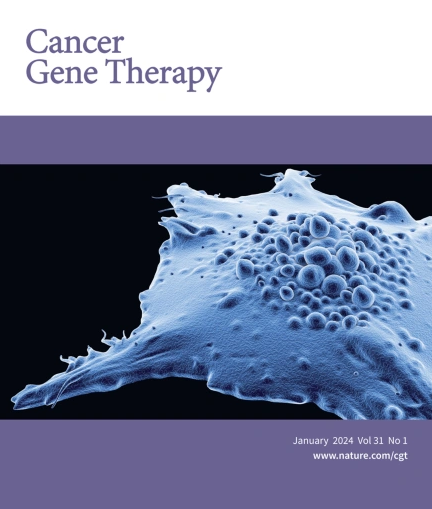Cell-intrinsic platinum response and associated genetic and gene expression signatures in ovarian cancer
IF 5
3区 医学
Q1 BIOTECHNOLOGY & APPLIED MICROBIOLOGY
引用次数: 0
Abstract
Ovarian cancers are still largely treated with platinum-based chemotherapy as the standard of care, yet few biomarkers of clinical response have had an impact on clinical decision making. Previous work has relied on poor models of the most common subtypes of epithelial ovarian cancers and necessitates a careful examination of the most suitable in vitro models. We performed extensive drug dose response assays and gene expression profiling on 36 ovarian cancer cell lines across over seven subtypes. This is the largest quantitative database of quantitative cisplatin and carboplatin response in ovarian cancer cell lines. Our results demonstrate that cell lines largely fall either well above or below the clinical maximally achievable dose (Cmax) of each compound. We performed differential expression analysis for high-grade serous ovarian carcinoma cell lines. Further, we generated two platinum-resistant derivatives each for OVCAR3 and OVCAR4. Combined with clinically resistant PEO1/PEO4/PEO6 and PEA1/PEA2 isogenic models, we performed differential expression analysis for seven platinum-resistant isogenic pairs. Common themes in differential expression were innate immunity/STAT activation, epithelial-to-mesenchymal transition (EMT) and stemness, and platinum influx/efflux regulators. We also performed copy number signature analysis and orthogonal measures of homologous recombination deficiency (HRD) scar scores and copy number burden, which is the first report to our knowledge applying field-standard copy number signatures to ovarian cancer cell lines. We also examined markers and functional readouts of stemness that revealed that cell lines are poor models for examination of stemness contributions to platinum resistance, suggesting that this is a transient state. Overall, this study serves as a resource to determine the best cell lines to utilize for ovarian cancer research on certain subtypes and platinum response studies, as well as sparks new hypotheses for future study in ovarian cancer.

卵巢癌细胞内铂反应及相关遗传和基因表达特征
卵巢癌在很大程度上仍以铂类化疗作为治疗标准,但很少有临床反应的生物标志物对临床决策产生影响。以前的工作依赖于最常见的上皮性卵巢癌亚型的不良模型,需要仔细检查最合适的体外模型。我们对7种亚型的36种卵巢癌细胞系进行了广泛的药物剂量反应测定和基因表达谱分析。这是卵巢癌细胞系中最大的顺铂和卡铂定量反应的定量数据库。我们的结果表明,细胞系在很大程度上高于或低于每种化合物的临床最大可达到剂量(Cmax)。我们对高级别浆液性卵巢癌细胞系进行了差异表达分析。此外,我们为OVCAR3和OVCAR4分别生成了两种抗铂衍生物。结合临床耐药的PEO1/PEO4/PEO6和PEA1/PEA2等基因模型,我们对7对铂耐药等基因对进行了差异表达分析。差异表达的共同主题是先天免疫/STAT激活,上皮细胞到间质转化(EMT)和干性,以及铂的内流/外排调节因子。我们还对同源重组缺陷(HRD)疤痕评分和拷贝数负担进行了拷贝数签名分析和正交测量,这是我们所知的第一个将现场标准拷贝数签名应用于卵巢癌细胞系的报告。我们还检查了干性的标记和功能读数,显示细胞系是检测干性对铂抗性贡献的不良模型,这表明这是一种短暂状态。总的来说,本研究为确定卵巢癌某些亚型研究和铂反应研究的最佳细胞系提供了资源,并为未来卵巢癌研究提出了新的假设。
本文章由计算机程序翻译,如有差异,请以英文原文为准。
求助全文
约1分钟内获得全文
求助全文
来源期刊

Cancer gene therapy
医学-生物工程与应用微生物
CiteScore
10.20
自引率
0.00%
发文量
150
审稿时长
4-8 weeks
期刊介绍:
Cancer Gene Therapy is the essential gene and cellular therapy resource for cancer researchers and clinicians, keeping readers up to date with the latest developments in gene and cellular therapies for cancer. The journal publishes original laboratory and clinical research papers, case reports and review articles. Publication topics include RNAi approaches, drug resistance, hematopoietic progenitor cell gene transfer, cancer stem cells, cellular therapies, homologous recombination, ribozyme technology, antisense technology, tumor immunotherapy and tumor suppressors, translational research, cancer therapy, gene delivery systems (viral and non-viral), anti-gene therapy (antisense, siRNA & ribozymes), apoptosis; mechanisms and therapies, vaccine development, immunology and immunotherapy, DNA synthesis and repair.
Cancer Gene Therapy publishes the results of laboratory investigations, preclinical studies, and clinical trials in the field of gene transfer/gene therapy and cellular therapies as applied to cancer research. Types of articles published include original research articles; case reports; brief communications; review articles in the main fields of drug resistance/sensitivity, gene therapy, cellular therapy, tumor suppressor and anti-oncogene therapy, cytokine/tumor immunotherapy, etc.; industry perspectives; and letters to the editor.
 求助内容:
求助内容: 应助结果提醒方式:
应助结果提醒方式:


